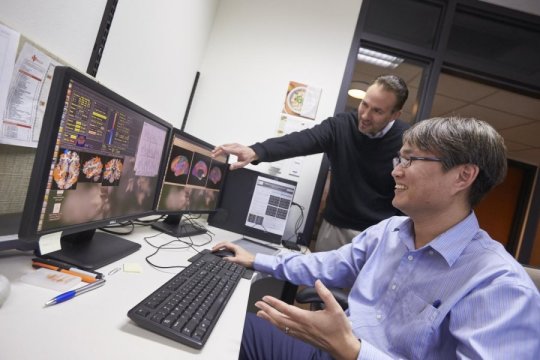Study: Disruptions in brain connectivity may explain TBI-related cognitive deficits

– Drs. Dan Krawczyk and Kihwan Han review MRI scans. Credit: Center for BrainHealth, Randy Anderson
Brain connectivity disruptions may explain cognitive deficits in people with brain injury (UT-Dallas release):
“Cognitive impairment following a traumatic brain injury (TBI) is common, often adversely affecting quality of life for those 1.7 million Americans who experience a TBI each year. Researchers at the Center for BrainHealth at The University of Texas at Dallas have identified complex brain connectivity patterns in individuals with chronic phases of traumatic brain injury which may explain long term higher order cognitive function deficits.
A study recently published in the Journal of International Neuropsychological Society found that individuals who are at least six months post-injury exhibit between-network, long-range and inter-hemispheric connectivity disruptions.
“Much research has focused on separating out individual brain networks…This is the first study of its kind to show the intercorrelations among different networks and disruptions among them in individuals with TBI.”
Study: Disrupted Intrinsic Connectivity among Default, Dorsal Attention, and Frontoparietal Control Networks in Individuals with Chronic Traumatic Brain Injury (Journal of International Neuropsychological Society)
- Objectives: Individuals with chronic traumatic brain injury (TBI) often show detrimental deficits in higher order cognitive functions requiring coordination of multiple brain networks. Although assessing TBI-related deficits in higher order cognition in the context of network dysfunction is promising, few studies have systematically investigated altered interactions among multiple networks in chronic TBI.
- Conclusion: Our findings suggest that assessing multiple networks-of-interest simultaneously will allow us to better understand deficits in goal-directed cognition and other higher order cognitive phenomena in chronic TBI. Future research will be needed to better understand the behavioral consequences related to these network disruptions.
To learn more:


